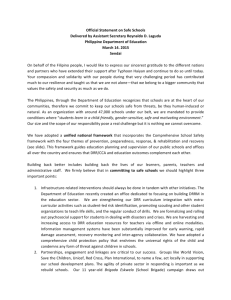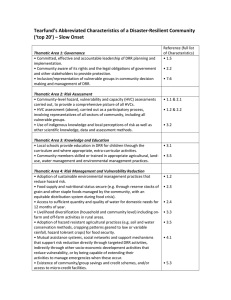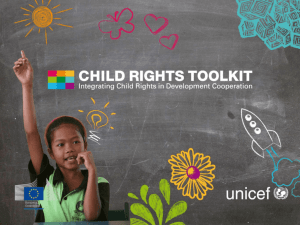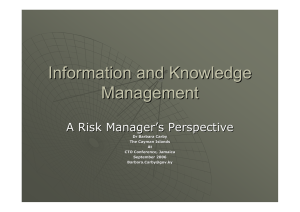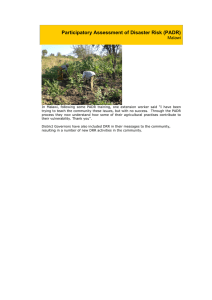Understanding Community Resilience Characteristics of Disaster Resilience Community
advertisement
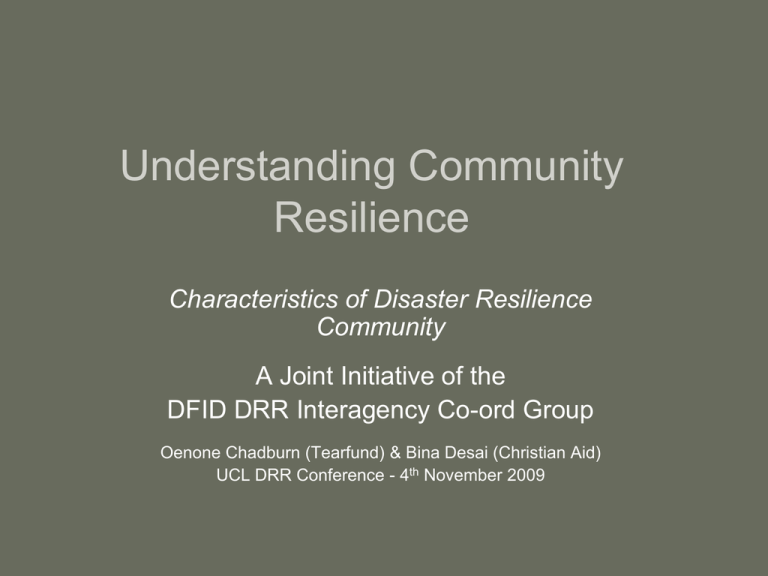
Understanding Community Resilience Characteristics of Disaster Resilience Community A Joint Initiative of the DFID DRR Interagency Co-ord Group Oenone Chadburn (Tearfund) & Bina Desai (Christian Aid) UCL DRR Conference - 4th November 2009 A small story… Development of Characteristics • Group of DFID funded agencies came together to debate M&E for DRR projects Limited resources available for measuring community based success John Twigg advised evidence base for community based DRR was limited • Commissioned the development of global generic indicators around HFA How do you demonstrate impact when your goal is prevention of an event or consequence?... ...And what exactly does a community should look like when all the Hyogo Actions have been successfully and sustainability completed? Evolution of Characteristics • Beyond indicators to develop a positive “vision” of what should be • Designed as a resource not a tool • Multi hazard, multi functional and multi dimensional • Tremendous response to field testing • Global active use by academics, international organisations as well as NGOs • “Second” edition practitioner orientated with more climate change reference Component of Resilience Characteristics of a Disaster Resilient Community Characteristics of an Enabling Environment 2. 2.1 Community vulnerability and capacity assessments (VCAs) carried out which provide comprehensive picture of vulnerabilities and capacities. 2.2 VCA is participatory process including representatives of all vulnerable groups. 2.3 Assessment findings shared, discussed, understood and agreed among all stakeholders and feed into community disaster planning. 2.4 VCAs used to create baselines at start of community DRR projects. 2.5 Findings made available to all interested parties (within and outside community) and feed into their disaster and development planning. 2.6 Ongoing monitoring of vulnerability and updating of assessments. 2.7 Skills and capacity to carry out community VCA maintained through support and training. VCA mandated in public policy, legislation, etc., with standards for preparation, publication, revision. Vulnerability and capacity indicators developed and systematically mapped and recorded (covering all relevant social, economic, physical and environmental, political, cultural factors). Disaster impact data and statistical loss information available and used in VCA. Systematic use of VCA in higher-level development programming. Vulnerable groups and causes of vulnerability identified. Existing knowledge collected, synthesised and shared systematically (through disaster management information systems). Participation of all relevant agencies/stakeholders in assessments. Government (local and/or national) and NGOs committed to providing technical and other support to local and community VCA. Vulnerability and impact data and assessment Use of Characteristics Opportunity to • rethink resilience • review priorities and choices • assess capacity Key principles for application • participatory • facilitated • customised (for different users and purposes) Versatility of „uses‟: from project cycle management to strategic planning and research & advocacy. Characteristics for Strategic Planning Background and process • Regional strategy for DRR and climate change adaptation in Central America • Joint process with partner organisations in El Salvador, Guatemala, Honduras and Nicaragua • Selection of Components of Resilience as „priority lines of action‟ for advocacy and community development work Characteristics for Strategic Planning Results • 4 months to develop a 5 year regional strategy • Producing a strong consensus on complex issues • Characteristics become accepted framework and reference document Advocacy – main priority: Policies, planning and political commitment to DRR & adaptation Advocacy – secondary priorities: Legal and regulatory systems, partnerships, accountability and community participation Community work – main priorities: Environmental and natural resource management, adaptation and secure livelihoods Community work – secondary priorities: Health and well-being, physical protection and planning systems. Characteristics for Capacity Assessment • Characteristics exercise to assess capacity of partners in Malawi • Also designed to help partners compare and learn, plus understand capacity gaps • Methodology was to apply “Attitude Skills Knowledge” (ASK) approach to selected Characteristics – i.e. if partners wanted to work with community to achieve a certain characteristic, what Attitude, Skills, Knowledge and would they need as local facilitating NGO Results and Learning For Partners • Value of partnerships and networking • The broad integration of DRR with other fields of practise such as social protection and food security etc • Need for specific technical expertise such as civil engineers, watsan engineers etc For Facilitator • Half day workshop too short • Exercise useful to understand full scope of DRR • Partners need to be high capacity • Specific attention needs to be given to understanding the “enabling environment” Summary of Lessons Learnt Challenges remain, but they are not insurmountable: • Need to engage in an in-depth way • Owned by all stakeholders • Requires „expert‟ facilitation • Surveys and baseline assessments Opportunities abound, we just need to seize them: • Diversity of DRR approached brought together • Characteristics give concrete examples instead of abstract concepts • Improved programme planning and real advocacy opportunities Characteristics as a Bridge Builder? • Ensuring that the HFA does not stand isolated from Climate Change Adaptation policy and implementation – how can the Characteristics support the ongoing development of integrated risk management? • Documentation of the success of DRR at community level still required – can the Characteristics be integrated into other assessment methodologies such as Cost Benefit Analysis? • Factoring risk reduction approaches into complex political emergencies – can the Characteristics support humanitarian practises and approaches to safe guard communities? Thank You Any Questions?

